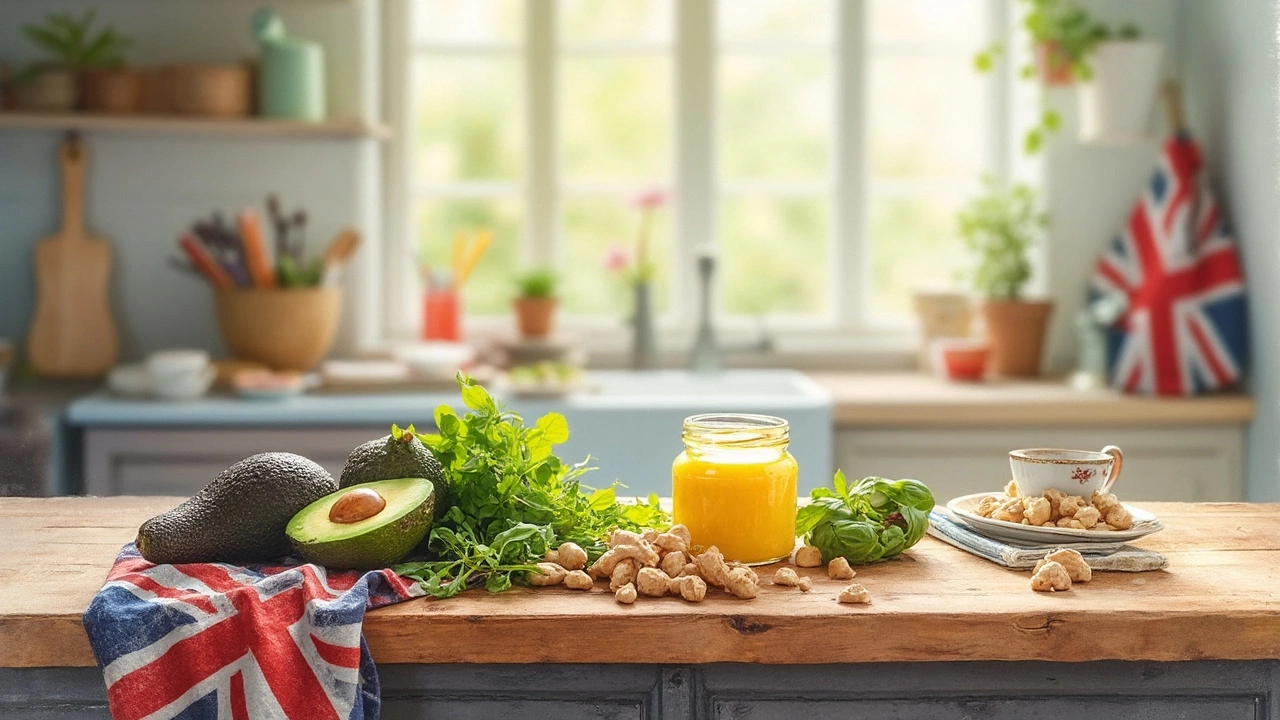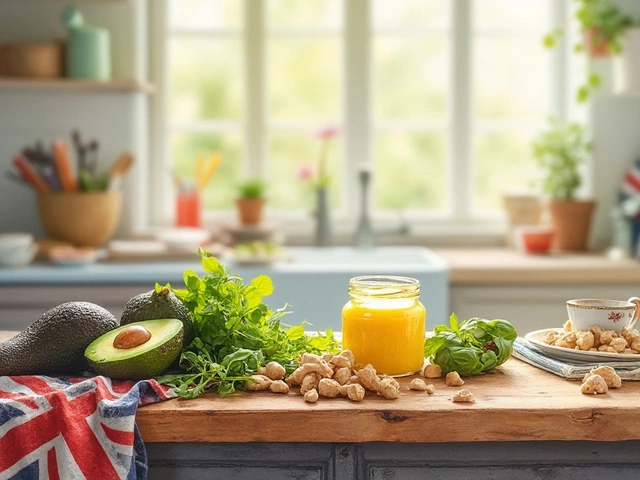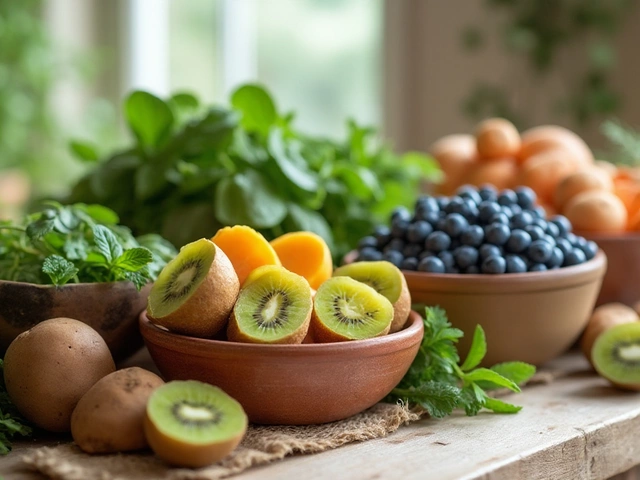Mayonnaise, that creamy spread often found in sandwiches and salads, typically isn't what you'd call vegan-friendly. Traditional mayo gets its richness from eggs and oil, which is a no-go for anyone following a plant-based lifestyle. But don't lose hope just yet—there are plenty of options out there for the vegan crowd. Let's see how.
First off, let's chat about why regular mayonnaise isn't vegan. Classic mayo is all about that blend of eggs and oil coming together in a creamy emulsion. It's tasty, sure, but eggs mean it's off the menu for vegans. The good news? There's a growing range of vegan mayonnaise options using egg-free ingredients that still satisfy those creamy cravings.
Haven't tried vegan mayonnaise yet? You might be surprised how easy it is to ditch the eggs without losing flavor. Brands now use ingredients like aquafaba (the liquid from canned chickpeas) or soy protein to get that same velvety texture you love. With a few tweaks, you can enjoy mayonnaise without stepping away from your vegan principles.
- Traditional Mayonnaise Ingredients
- Understanding Vegan Mayonnaise
- Plant-Based Ingredients to Watch For
- DIY Vegan Mayonnaise Recipe
- Popular Vegan Mayonnaise Brands
- Tips for Using Vegan Mayonnaise
Traditional Mayonnaise Ingredients
We all know the classic mayo as that creamy, tangy condiment that brings many dishes together. But what exactly goes into traditional mayo? Let's break it down.
Egg Yolks: The Binding Agent
The heart of traditional mayonnaise lies in the egg yolks. They are crucial because they act as an emulsifier. What's an emulsifier, you ask? It's something that helps mix two ingredients that usually wouldn't blend together, like oil and water. In mayo, egg yolks help give it that thick and creamy consistency.
The Role of Oil
Oil is the other main player in traditional mayonnaise. Usually, it's something neutral like canola or vegetable oil so that it doesn't overpower the flavor. The oil is slowly whisked into the egg yolks, creating that smooth emulsion we crave in our sandwiches and salads.
Tangy Additions
The zing from vinegar or lemon juice is what gives mayonnaise its distinctive tang. These acids also help thicken the emulsion and act as preservatives, extending the shelf life of the mayo.
Optional Add-ons
Sometimes a bit of mustard or even a pinch of salt is added to enhance the flavor. Mustard can also help stabilize the emulsion, keeping everything nicely mixed.
A Quick Ingredient Snapshot
| Ingredient | Purpose |
|---|---|
| Egg yolks | Emulsifier and thickener |
| Oil | Main fat component for creaminess |
| Vinegar or Lemon Juice | Adds tang and acts as a preservative |
| Mustard | Flavor enhancement and emulsion stabilization |
So there you have it, the key ingredients making up traditional mayonnaise. For those of us living a vegan lifestyle, these ingredients mean we have to look for alternatives, but it's good to know what we're working with in the first place.
Understanding Vegan Mayonnaise
If you're diving into the world of vegan mayonnaise, it's pretty cool to see all the creative alternatives popping up. But what really makes mayo vegan? The main thing is swapping out eggs for plant-based ingredients, but there's more to it than just removing eggs.
What Goes In Vegan Mayo?
At its core, vegan mayo tries to replicate the texture and taste of traditional mayonnaise without using animal products. So what do they use instead of eggs? Often, you'll find ingredients like aquafaba (which is the liquid left after cooking chickpeas) or soy protein. Plant-based mayo relies on these ingredients to achieve that familiar creaminess and stability.
Why The Buzz About Aquafaba?
Aquafaba is quite the star in the vegan world because it's a fantastic thickener and emulsifier, mimicking what eggs do in mayo perfectly. It's all about the proteins and starches in that chickpea water. Next time you open a can of chickpeas, you'll know what's up!
Oil and Flavoring in Vegan Mayo
Just like the traditional kind, oil is still a big deal in vegan-friendly mayonnaise. Most recipes stick to canola or sunflower oil, which helps keep that creamy texture. And of course, a touch of salt, vinegar, and maybe lemon juice rounds out the flavor.
What's the Cost Comparison?
Before you grab a jar, you might wonder, is this going to cost me an arm and a leg? Generally, vegan mayo can be a bit pricier than regular mayo, but as more brands hit the shelves, the prices are coming down. Here's a simple comparison for perspective:
| Type | Average Price (USD) |
|---|---|
| Traditional Mayo | 3 |
| Vegan Mayo | 5 |
So, whether you're looking to cut out animal products for ethical reasons, allergies, or you're just curious, knowing what goes into vegan mayonnaise helps you make an informed choice. The best part? You won't have to miss out on your favorite foods while sticking to your vegan lifestyle.
Plant-Based Ingredients to Watch For
When it comes to making vegan mayonnaise, it's all about finding the right alternatives to eggs while keeping that creamy taste we love. Some ingredients stand out for their ability to recreate the traditional mayo feel without any animal products.
Aquafaba
This might sound fancy, but it's actually just the liquid from a can of chickpeas. Aquafaba is a magical ingredient that acts a lot like egg whites. It's great for making egg-free dishes, and it's a key player in many vegan mayo recipes. Just a few tablespoons can give your mayo that perfect, fluffy texture.
Soy Milk
Soy milk is another popular base for plant-based mayo. It's rich and creamy, helping to mimic the consistency of traditional mayonnaise. Plus, it's packed with protein, which is always a bonus. Make sure to go for the unsweetened kind for best results.
Apple Cider Vinegar
This one isn't about emulating eggs but rather getting that tangy flavor mayo is known for. Apple cider vinegar makes sure your vegan mayo has that slight zing. It keeps things fresh-tasting and pairs perfectly with the oil to create the right balance.
Oil Options
Oil is essential in any type of mayonnaise. For vegan-friendly mayonnaise, light-flavored oils like canola or sunflower are usually best. They provide the fatty richness without overpowering the other flavors. If you're being health-conscious, you might even give avocado oil a try—it's a bit more flavorful but super nutritious.
Lemon Juice
Much like apple cider vinegar, lemon juice contributes to the tanginess, and a freshly squeezed lemon can add a fresh flavor pop. It's the little things like this that elevate your homemade vegan mayo from okay to wow.
With these ingredients, you can easily whip up a mayo that not only fits your plant-based needs but tastes great too. These swaps might sound simple, but they make all the difference in turning something basic into something special.

DIY Vegan Mayonnaise Recipe
Ready to whip up some homemade vegan mayonnaise? It's easier than you might think, and you'll love how customizable it is. Plus, making it yourself ensures it's fresh and free of any sneaky additives.
Ingredients You'll Need
- 1/2 cup unsweetened soy milk or aquafaba
- 1 teaspoon apple cider vinegar
- 1 teaspoon Dijon mustard
- 3/4 cup neutral oil (like canola or sunflower)
- 1/2 teaspoon salt
- 1 teaspoon lemon juice
- A pinch of sugar (optional, for a hint of sweetness)
Step-by-Step Instructions
- Start with the liquids: In a blender, combine the soy milk or aquafaba, apple cider vinegar, and mustard. Blend on high for a few seconds until mixed.
- Add the oil: Next, with the blender on low speed, slowly drizzle the oil in. This step is key for emulsifying the mixture, giving that creamy texture.
- Season and finish: Once all the oil is incorporated, add the salt, lemon juice, and sugar if you're using it. Blend again briefly to make sure everything's well mixed.
- Taste and tweak: Give it a taste and adjust seasonings if needed. Maybe a touch more salt or lemon juice to suit your preference.
- Chill out: Pour your freshly-made mayo into a jar and refrigerate. It’ll thicken a bit more as it cools.
Quick Tips for Success
- Choose your oil wisely: A neutral-flavored oil is your best bet. You don't want the oil overpowering the mayo's taste.
- Blending technique: If you have an immersion blender, it's great for making mayo directly in the jar you plan to store it in.
- Variations: Want more flavor? Add garlic for a zesty kick or a spoonful of sriracha for some heat!
With this easy recipe, you'll be spreading plant-based mayo on your sandwiches or mixing it into potato salad in no time. You might even find it beats store-bought in terms of taste and freshness!
Popular Vegan Mayonnaise Brands
Finding the perfect vegan mayonnaise can feel a bit like a treasure hunt, but luckily, there are some standout brands that have become favorites in the plant-based community. These options bring the same satisfying creaminess you'd expect from traditional mayo without the eggs.
Follow Your Heart Vegenaise
Follow Your Heart has been around for a while and their Vegenaise is a staple for many vegans. It comes in several varieties including Original, Garlic Aioli, and Soy-Free, offering something for different taste preferences and dietary requirements. Customers love its rich texture and how it closely mirrors the mayo we grew up with.
Sir Kensington's Fabanaise
Sir Kensington's jumped into the vegan-friendly game with their Fabanaise, leveraging the magic of aquafaba—the liquid in canned chickpeas. This revolutionary ingredient mimics the properties of egg whites, creating a mayo variant that tastes great and feels right at home in sandwiches and salads.
Just Mayo
Just Mayo by Eat Just, Inc. is known for its simple, clean ingredients, and delicious taste. Available in several flavors like Chipotle or Garlic, this brand has won over many who love a bit of variety. Despite some legal hurdles in the past over the name, its popularity shows it's a winner among those seeking egg-free mayo options.
Best Foods Vegan Dressing and Spread
Best Foods, also known as Hellmann's in some parts of the world, offers a vegan version of their classic mayo. Fans rave about how close it replicates the traditional taste. It's smooth, consistent, and an excellent choice for those transitioning to more plant-based mayo alternatives.
| Brand | Main Ingredient | Popular Flavor |
|---|---|---|
| Follow Your Heart | Expeller-Pressed Canola | Original |
| Sir Kensington's | Aquafaba | Dijon |
| Just Mayo | Pea Protein | Garlic |
| Best Foods | Sunflower Oil | Original |
Trying out these brands can be a fun way to explore the world of veganism, even if you're just looking for a healthier mayo option. Each offers unique ingredients and flavors while ensuring that creamy texture without the eggs.
Tips for Using Vegan Mayonnaise
Switching to vegan mayonnaise is just the start. How do you use it to get the best results? Here's the lowdown on making the most of this plant-based mayo in your everyday meals.
1. Perfect for Sandwiches and Wraps
Let's start with the classic use: slathering it on sandwiches and wraps. Vegan mayonnaise keeps things moist and tasty, bringing the same creaminess you expect from traditional mayo. Try it in a veggie-laden wrap or a toasted club sandwich with plant-based bacon.
2. Whipping Up Creamy Dressings
Want a quick salad dressing? Mix vegan mayonnaise with some Dijon mustard and a squeeze of lemon juice. Throw in some herbs like dill or basil for extra flavor. You’ll find it blends easily, no clumps or weird textures. It’s just smooth, creamy goodness ready to elevate any salad.
3. A Base for Dips and Spreads
Use vegan mayo as the base for your favorite dips or as a substitute in your go-to spread recipes. It's the perfect companion to turn an average veggie tray into a star player at your next party. Stir in sriracha for some heat or garlic powder and parsley for a classic French onion dip vibe.
4. Creative Cooking
Ever thought about adding a dollop in your baking? It may sound wild, but some bakers swear by using a bit of mayo in cakes to boost moisture. Try a small amount in your next batch of muffins or chocolate cake for a surprisingly rich texture.
5. Storing and Shelf Life
Always check the label for storage instructions. Most vegan mayos need refrigeration after opening—just like the regular stuff. They generally have a good shelf life, but it's best to give it a sniff test before using if it’s been sitting around for a while.
Here's a quick comparison of how popular vegan mayonnaise brands stack up in terms of taste and texture:
| Brand | Taste Rating | Texture Rating |
|---|---|---|
| Just Mayo | 9/10 | 8/10 |
| Vegenaise | 8/10 | 9/10 |
| Hellmann’s Vegan Mayo | 8.5/10 | 8.5/10 |
Experimenting with egg-free mayo can lead to delicious new discoveries in your kitchen. So go ahead, grab that jar and start scooping. Your taste buds will thank you!








Write a comment